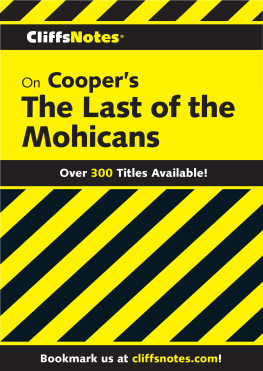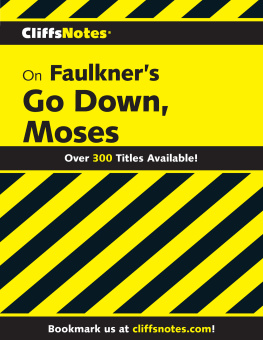Baird Searles - CliffsNotes on Heinleins Works
Here you can read online Baird Searles - CliffsNotes on Heinleins Works full text of the book (entire story) in english for free. Download pdf and epub, get meaning, cover and reviews about this ebook. year: 1999, publisher: HMH Books, genre: Art. Description of the work, (preface) as well as reviews are available. Best literature library LitArk.com created for fans of good reading and offers a wide selection of genres:
Romance novel
Science fiction
Adventure
Detective
Science
History
Home and family
Prose
Art
Politics
Computer
Non-fiction
Religion
Business
Children
Humor
Choose a favorite category and find really read worthwhile books. Enjoy immersion in the world of imagination, feel the emotions of the characters or learn something new for yourself, make an fascinating discovery.
- Book:CliffsNotes on Heinleins Works
- Author:
- Publisher:HMH Books
- Genre:
- Year:1999
- Rating:4 / 5
- Favourites:Add to favourites
- Your mark:
- 80
- 1
- 2
- 3
- 4
- 5
CliffsNotes on Heinleins Works: summary, description and annotation
We offer to read an annotation, description, summary or preface (depends on what the author of the book "CliffsNotes on Heinleins Works" wrote himself). If you haven't found the necessary information about the book — write in the comments, we will try to find it.
This CliffsNotes guide includes everything youve come to expect from the trusted experts at CliffsNotes, including analysis of the most widely read literary works.
CliffsNotes on Heinleins Works — read online for free the complete book (whole text) full work
Below is the text of the book, divided by pages. System saving the place of the last page read, allows you to conveniently read the book "CliffsNotes on Heinleins Works" online for free, without having to search again every time where you left off. Put a bookmark, and you can go to the page where you finished reading at any time.
Font size:
Interval:
Bookmark:
Copyright 1975, 1999 Houghton Mifflin Harcourt Publishing Company
All rights reserved.
www.hmhco.com
cliffsnotes.com
For information about permission to reproduce selections from this book, write to or to Permissions, Houghton Mifflin Harcourt Publishing Company, 3 Park Avenue, 19th Floor, New York, New York 10016.
The publisher and the author make no representations or warranties with respect to the accuracy or completeness of the contents of this work and specifically disclaim all warranties, including without limitation warranties of fitness for a particular purpose. No warranty may be created or extended by sales or promotional materials. The advice and strategies contained herein may not be suitable for every situation. This work is sold with the understanding that the publisher is not engaged in rendering legal, accounting, or other professional services. If professional assistance is required, the services of a competent professional person should be sought. Neither the publisher nor the author shall be liable for damages arising herefrom. The fact that an organization or website is referred to in this work as a citation and/or a potential source of further information does not mean that the author or the publisher endorses the information the organization or website may provide or recommendations it may make. Further, readers should be aware that Internet websites listed in this work may have changed or disappeared between when this work was written and when it is read.
Trademarks: CliffsNotes, the CliffsNotes logo, Cliffs, cliffsnotes.com, and all related trademarks, logos, and trade dress are trademarks or registered trademarks of Houghton Mifflin Harcourt Publishing Company. All other trademarks are the property of their respective owners. Houghton Mifflin Harcourt is not associated with any product or vendor mentioned in this book.
eISBN 978-0-544-18198-4
v1.0117
Robert Anson Heinlein was born in Butler, Missouri, on July 7, 1907, to Rex Ivan and Bam H. Heinlein. The family is of German, Irish, and French extraction, resident in America since before the American Revolution. Robert was one of seven children, four boys and three girls; when he was still quite young, the family moved from Butler to Kansas City, where he was educated in the Kansas City public school system. After finishing high school in 1924 and studying a year at the University of Missouri, Heinlein entered the U.S. Naval Academy at Annapolis, majoring in naval science. He graduated twentieth in a class of 243 (as well as distinguishing himself at fencing at the Academy) in 1929 and subsequently served on active duty in the navy as line officer on destroyers and the then-experimental aircraft carriers.
Heinlein retired from the Navy in 1934 as permanently disabled after a severe case of tuberculosis, so severe that he had described himself as an invalid in the 1930s. Nevertheless, he entered the University of California at Los Angeles in postgraduate courses in physics and mathematics, which he did not complete because of further health problems. He then spent a year of recuperation in Colorado.
After trying several fields, such as real estate, mining, politics, and architecture, Heinlein (who had been an avid reader of science fiction for most of his life) sold his first story to Astounding Science Fiction in 1939. It was written in four days, and he received $70 for it. While not exactly a princely sum, it was good for a period that was still part of the Depression.
His success with the readers of science fiction was not instantaneous, but certainly rapid. By the end of 1941 and the entry of the United States into World War II, he was writing prolifically (under his own name and several pseudonyms) and had become a major figure in the field. Heinlein did no writing during World War II; his time was devoted to working as a civilian engineer in the Naval Air Material Center in Philadelphia. After the war, he returned to California and resumed writing, but not only for the science-fiction magazines. Taking advantage of the growing interest in science fiction, engendered by the ramifications of the atomic bomb and other scientific developments of the war, he pioneered new markets, such as the slick fiction magazines of the period, juveniles, and even film and early television writing. He has been credited with the invention of one of TVs earliest science-fiction heroes, Tom Corbett: Space Cadet, and was one of three writers involved in the film which started a new trend in cinematic science fiction, Destination Moon.
In 1948, Heinlein married Virginia Gerstenfeld, an engineer and chemist, with whom he had worked during the war. From 1950 to 1966, the Heinleins resided in Colorado, then returned to California, where they lived in a circular, highly engineered house, the design of which Heinlein had much to do with. He appeared as a guest commentator on network television, covering the first Lunar landing. He has won the Hugo award (one of two major awards in the field, this one voted by the membership of the Annual World Science-Fiction Convention) for Double Star (1956), Starship Troopers (1959), Stranger in a Strange Land (1961), and The Moon Is a Harsh Mistress (1966). Although he has never won a Nebula (the annual award voted by the Science Fiction Writers of America) for a specific work, on April 26, 1975, he was presented a special Grand Master Award Nebula by the Science Fiction Writers of America.
Heinlein died on May 8, 1988, in Carmel, California.
Robert A. Heinlein, despite his talents as a creator of science fiction, did not appear from nowhere; he particularly did not appear from nowhere with a book called Stranger in a Strange Land, though to the majority of his readers it may seem that he did just that. This was one of the first works of science fiction to make an impact on the general public. Heinlein had labored long before then, perfecting his skills as a science-fiction writer. Thus a brief look at the history of science fiction and the milieu in which Heinlein first began to write will be helpful in understanding this.
Frankenstein, as Brian Aldiss points out in his intelligent history of science fiction, Billion Year Spree, might well be considered the first true work of science fiction, a sort of mutant child of the Gothics. The literate minds of the nineteenth century were then beginning to view science as the inevitable vehicle of progress, a form of literature based on this premiseon the possible, if not probable, results of whatever science came up being a logical extension of this view.
The first wave peaked with Jules Verne and his adventure stories, usually built around one specific new invention; later, another peak was reached with H. G. Wells, with a more British view of the social problems raised by scientific progress. Then the impetus was transferred to America, a move probably directly related to the transfer of world power. Here science fiction suffered a change in status, a change it was not to overcome until very recently.
In America, it took root as popular literature, reading matter for the literate masses, and the most sought was action adventure. The fiction magazines of the early part of the twentieth century offered action adventure in several settingsthe West; the cities, with stories of crime and detection; and, less often, on other worlds. The hero of these stories usually got there by semi-mystical means in the earliest examples, but a pseudo-scientific rationale became desirable for a more convincing story, and the space ship was adopted as the means of travel. The writer to first capture America with these concepts was Edgar Rice Burroughs, and he may well be regarded as the founding father of science fiction in the United States. The field became more sophisticated as the century progressed, but its virtues and flaws were directly analogous to those of Burroughs.
Next pageFont size:
Interval:
Bookmark:
Similar books «CliffsNotes on Heinleins Works»
Look at similar books to CliffsNotes on Heinleins Works. We have selected literature similar in name and meaning in the hope of providing readers with more options to find new, interesting, not yet read works.
Discussion, reviews of the book CliffsNotes on Heinleins Works and just readers' own opinions. Leave your comments, write what you think about the work, its meaning or the main characters. Specify what exactly you liked and what you didn't like, and why you think so.













